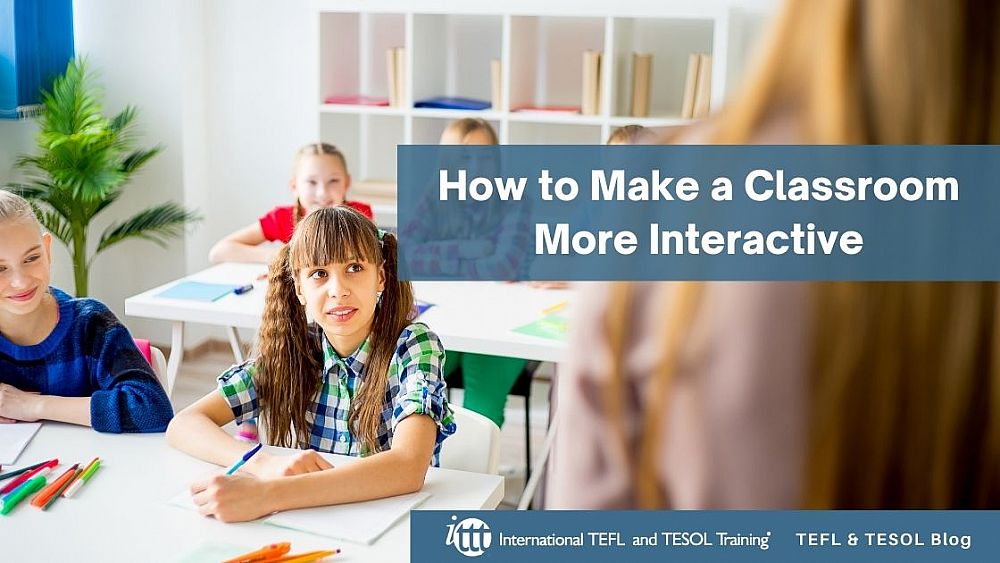How to Make a Classroom More Interactive

Interactive education is all about teaching students in a way that engages them directly in their learning process. There are numerous ways of building an engagement like this. Most of the time, it is by
Table of Contents
Are you ready to teach English?
Check out what our course grads say in our many video testimonials!
- the use of audio, video, and graphics,
- hands-on demonstrations and drills
- teacher-student interaction
- student-student interaction
You inspire the students to be involved in class participation, think independently, and use their minds, leading to a longer memory retention. The students' awareness grows, but their interest, strength, expertise, team spirit, and freedom of speech will also increase.
I will speak about the use of interactive teaching approaches in this blog post, urging more attention to the content of the lesson. We're going to see some interactive instruments, concepts, and games for teaching. Not only will I speak about the use of interactive methods of teaching, but I'll also give you some examples of methods used in the present classroom as well.
I want to put some activities in the spotlight first. Three of the most successful ways of promoting more expression in your classroom are the following engaging classroom exercises.
Think, pair, and share
Set an issue or a question around a certain subject and pair your students together. Give enough time to each pair of students so they can draw a correct conclusion and allow the children to express their conclusion in their speech. This way, the students will engage, interact, and remember more about the class.
Brainstorming
In group meetings, interactive brainstorming is often carried out. The process is useful for producing new thoughts and ideas. Brainstorming lets students learn and, above all, learn from each other. All the brilliant ideas they come up with will impress you!
Buzz session
In group sessions that concentrate on a single topic, participants come together. Every student shares their thoughts and ideas with each other. Encourage debate and cooperation within each community among the students. All should benefit from the suggestions and experiences of each other. As an instructor to ignite the conversation, you could give your students some keywords.
There are also several other interactive concepts for teaching, of course. I divided the tasks into various categories:* Student pair activities* Individual student activities* Interactive game activities* Student group activities
Exit slips
At the end of the class session, this is best used. You will ask the students to write about a particular question for one minute. It could be generalized to "What was the most important thing today that you learned?" Then, in the next lecture, you will decide if you are going to open up a discussion about it. You can ask them if they recollect what they wrote down.
Misconception check
Discover the assumptions of students. See if, when given a false truth, students can determine what the correct answer is. It's beneficial when reading through what they learned in the previous lesson,. This helps students to think deeply and wager on all the possibilities.
Circle the questions
Make a worksheet or a survey that has a list of questions about your subject (make them specific), and ask students to circle (or check) those they do not know the answers to. Then, let them turn the page around. Create corners regarding different questions that were circled. Let your students focus individually on the extra activities and explanations in the corners. You have to send each student a different and specific order to visit the corners, as the students would all have different questions circled.
Ask the winner
Ask students to solve a problem on the board. Once the response has been revealed, instruct those who got it right to lift their hands (and keep them raised). Then, in order to better grasp the issue and how to solve it next time, all other students have to speak to someone with a raised hand.
Pair-share-repeat
You may also ask students to find a new partner after a Think-pair-share experience, which I wrote about in the first interactive learning lesson model, and share the knowledge of the old partnership with this new partner.
Teacher and student
Let students brainstorm the last lesson's key points. Then, pair the students together and assign two tasks to them. The tutor is one of them, and the student is the other. The teacher's task is to sketch the key points, while the task of the student is to cross points on his list as they are listed and come up with 2 to 3 points missed by the teacher.
Wisdom from another
Pair students to share their findings after individual brainstorm or creative task. Then, invite volunteers who have considered the work of their partner to be fascinating or exceptional. Sometimes, students are more willing to publicly share the work of fellow students than their work. Of course, you should still allow their goals to be shared as well.
Are you ready to teach English?
Apply now & get certified to teach english abroad!
Speak with an ITTT advisor today to put together your personal plan for teaching English abroad!
Send us an email or call us toll-free at 1-800-490-0531 to speak with an ITTT advisor today.
Related Articles:
- How do I get a job teaching English in South Korea
- 5 Reasons Why Teaching English Abroad Enhances Your Career Prospects
- The 10 Best Destinations for Teaching English Abroad in 2018
- Online or In-Class - Which TEFL Course Should You Take?
- The Best Government Programs For Teaching English Abroad
- What Scams to Look Out for When Looking for TEFL Jobs



